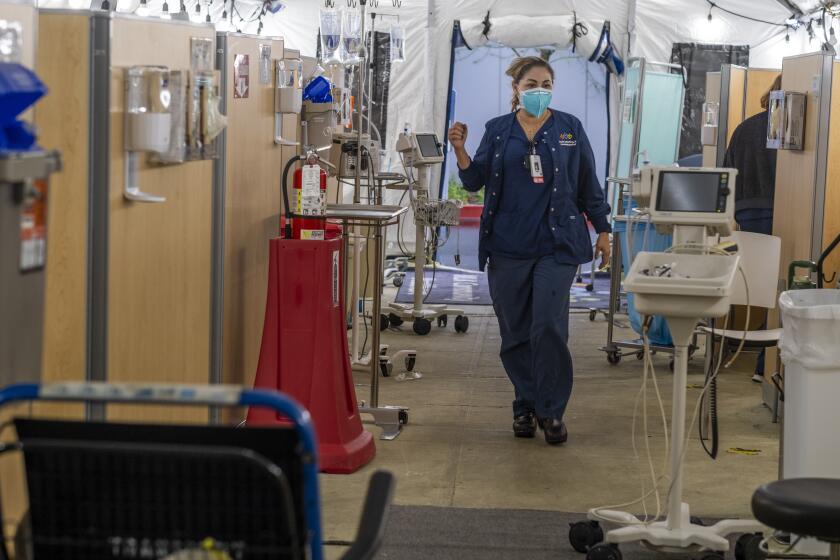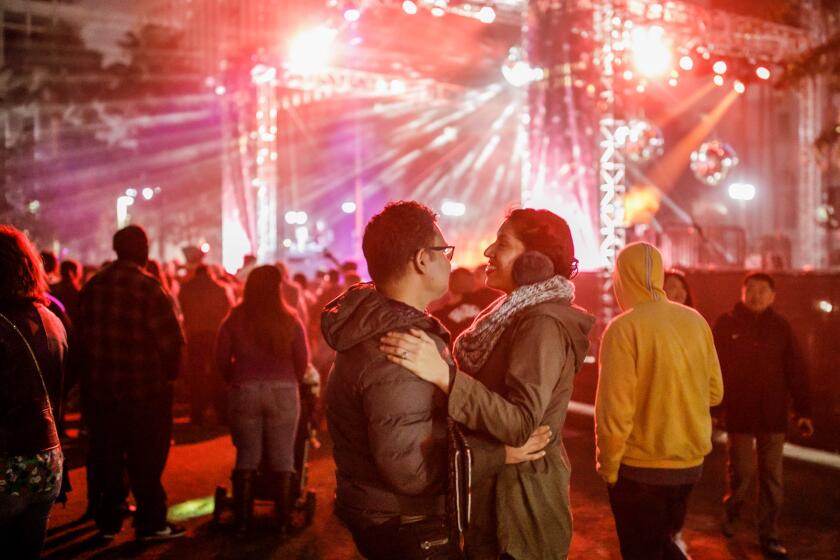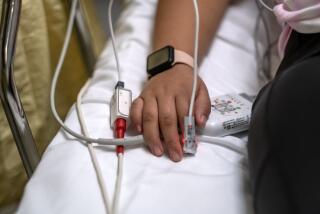San Diego County issues alert as emergency rooms overflow

SAN DIEGO — The emergency medical director of San Diego County issued a special alert Wednesday after the region’s emergency departments saw a significant increase in traffic driven in part by demand for coronavirus-related testing and care.
About half of the 22 hospitals across the region were so busy that they had to divert some ambulances to other facilities, a practice designed to give overburdened medical staffs time to catch up with crushing demand.
“If emergency departments are on diversion, then ambulances have to drive farther away and they’re less available to respond to 911 calls, which puts the whole system at risk,” said Dr. Kristi Koenig, medical director of San Diego County’s emergency medical system. “It’s not a good situation, one that we try to prevent whenever we can.”
Coming one day after a last-minute Holiday Bowl cancellation attributed to coronavirus cases in UCLA’s football program, the sudden increase in emergency visits Wednesday coincided with further evidence that the pandemic continues to worsen in San Diego County. There were 3,653 new positive test results listed for Tuesday, the largest single-day number published since Jan. 7, when 4,550 positives were recorded in a single day, the peak for last winter’s surge.
Thursday’s total, 20,198, is one of the highest in the pandemic. Over the last two days, the nation’s most populous county has reported nearly 37,000 new cases.
With most of the population now vaccinated, hospitals are faring much better than they did this time last year but are nonetheless still experiencing increases in admissions. There were 454 COVID-19 patients in county hospital beds Tuesday, up from 387 one week earlier. On that date last year, county records show, there were 1,562 COVID-19 hospital cases.
“Just this morning, 15 patients arrived in one hour that were all seeking treatment for COVID,” said Dr. Joshua McCabe, director of emergency services at Sharp Memorial Hospital in San Diego. “Between 8 and 9 in the morning, there was no other complaint in the ER except influenza-like symptoms that tested COVID-19 positive.”
This time around, he added, the patients seem to be less seriously sick than they were last year.
“When patients come in now with COVID, it’s more like a flu, and they’re just not feeling well,” McCabe said. “We’re not seeing them as often with low oxygen saturation levels like we were when COVID first started.”
That tracks with observations worldwide that the Omicron variant seems to cause less-severe illness, especially among vaccinated patients, than previous variants did.
A sharp spike in COVID cases, fueled in part by the Omicron variant, prompts health experts to urge revelers to scale back New Year’s Eve gatherings.
It’s of little comfort, though, as the sheer number of cases appears to be increasing more rapidly than it did last year and certainly more quickly that it did during the recent surge of the summer and early fall.
“More people are getting sick than ever before, and when people get sick with COVID, if they have any other diseases or are elderly, they certainly run a much higher risk of hospitalization and death,” McCabe said.
Rady Children’s Hospital in San Diego reported that 289 of the 1,173 tests its lab performed Wednesday came back positive, for a positivity rate of nearly 25%.
Rady reported not just high demand for coronavirus-related emergency care but also an increase in the number of children with cases that were severe enough to require hospitalization. As of Wednesday, 14 children were hospitalized at Rady with COVID-19. Though it was not clear whether that was a record, it is higher than it was last winter, when Rady’s hospitalized total was in the single digits.
Koenig, the county emergency medical director, noted that it often takes weeks after infection for patients to get sick enough to need medical attention.
Some percentage will get sick enough to need serious help, and with the larger numbers of infections expected to occur in the next few weeks, there could still be enough sheer volume to push hospitals past the brink, she said.
“Even though the percentage is lower, you can end up with a situation where the number [of hospitalizations] is higher because Omicron is just so transmissible,” Koenig said.
Hollywood is dealing with the latest COVID-19 surge in infections as a result of the new Omicron variant
The public is clearly very concerned about infection, with lines for testing stretching for blocks and many waiting hours to give a sample. Rapid tests seem to be scarce across the county.
Some test seekers, Koenig said, appear to be driving the surge in volume being seen at emergency departments, choosing to head to hospitals when testing centers can’t deliver quickly.
This trend, she said, is concerning due to low staffing levels at all medical facilities.
“I know it’s not easy, and the lines are long, but I would say look for another source for testing if that’s truly the only reason you’re going to the emergency department,” Koenig said.
There were 27 additional COVID-19 deaths listed in Wednesday’s weekly report. Most ranged in age from their early 60s to mid-90s with other co-occurring medical conditions present. The youngest was a 47-year-old man from northern San Diego County who died Dec. 21.
More to Read
Sign up for Essential California
The most important California stories and recommendations in your inbox every morning.
You may occasionally receive promotional content from the Los Angeles Times.














